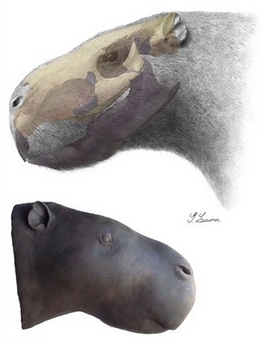Scientists discover huge extinct rodent
Updated: 2008-01-17 09:24
Blanco said the skull's shape and the huge incisors left no doubt they were dealing with a rodent, but he cautioned that the estimate of the animal's bulk was imprecise.
The extinct rodent clearly outclassed its nearest rival, the Phoberomys, found in Venezuela and estimated to weigh between 880 and 1,500 pounds.
 |
|
In this image released in London Wednesday, Jan. 16, 2008 by the Royal Society, an artist's illustration shows variations on the head of Josephoartigasia monesi, a newly discovered extinct species of rodent.[Agencies] |
He said the animal's teeth pointed to a diet of aquatic plants.
"From what we can tell, we know it was a herbivore that lived on the shores of rivers or alongside streams in woodland areas," Rinderknecht told the AP. "Possibly it had a behavior similar to other water-faring rodents that exist today, such as beavers, which split their time between land and water."
But he said the rodent appears to have had no tail, adding that follow-up studies are being planned to better determine its diet and other traits.
The creature may have been a contemporary to the saber-toothed cats and giant carnivorous birds that roamed the area millions of years ago, but Blanco said it was not clear whether such predators had the power necessary to bring down the huge beast.
"This investigation began about a year and a half ago but it's still not complete," Rinderknecht said, adding that the next step may be a CT scan of the skull "to better determine its interior dimensions."
The research by Rinderknecht and Blanco was published Wednesday in this week's issue of biological research journal, Proceedings of the Royal Society B.
Scientists uninvolved with the finding agreed that this was one really big rodent.
"I think it's a very important discovery -- it is certainly an immense animal," said Mary Dawson, a paleontologist at the Carnegie Museum of Natural History in Pittsburgh. She said it and other rodents grew bigger by filling the ecological niche taken elsewhere by rhinoceroses and hippopotamuses.
"They got large taking the role of some herbivores that were not present at that time -- South America was still an island continent," she said. But when North and South America were linked about 3 million years ago, the rodents were swamped by North American animals and eventually died out.
|
|
|
||
|
||
|
|
|
|

